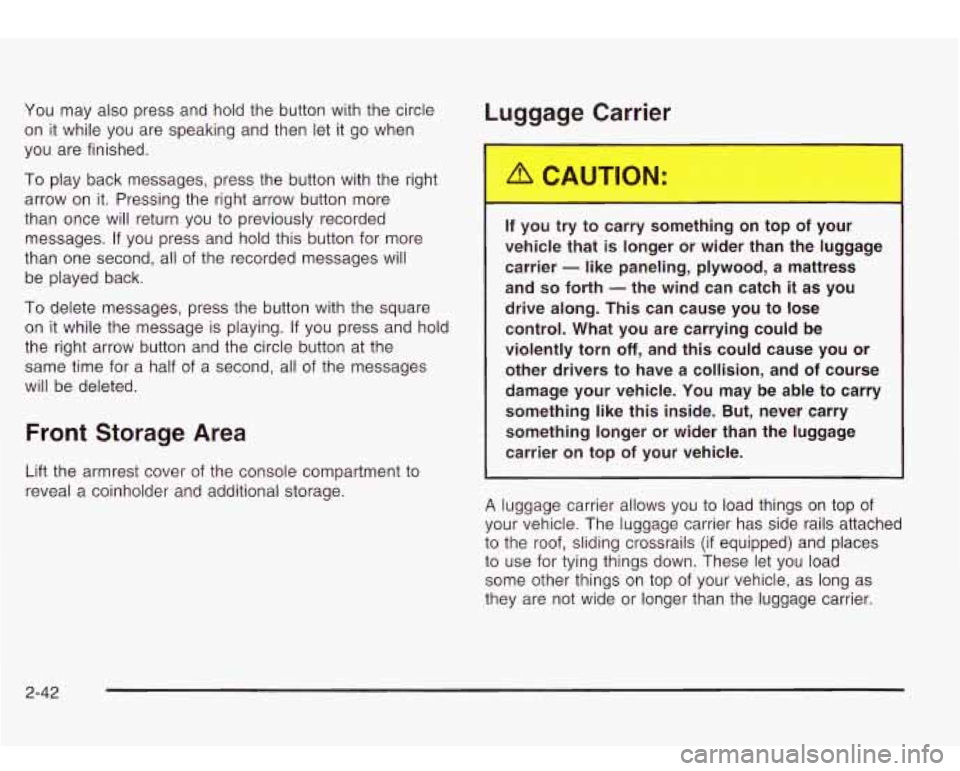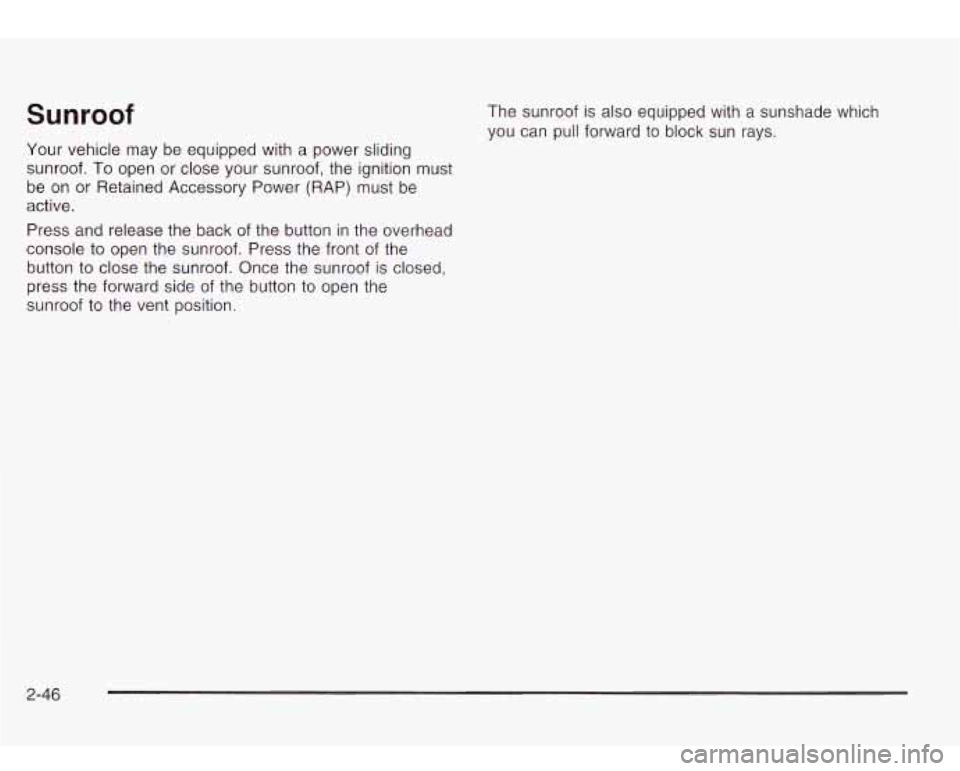2003 Oldsmobile Bravada roof
[x] Cancel search: roofPage 67 of 410

Section 2 Features and Controls
....... Storage Areas ................................................ 2.41 Sunroof ...................................... 2.46
Glove
Box ................................................... 2.41 Vehicle Personalization ............................... 2.47
Overhead Console ........................................ 2.41 Memory Seat ........................................... 2.47
Front Storage Area ....................................... 2.42
Luggage Carrier
........................................... 2.42
Rear Floor Storage Lid
.................................. 2.43
Convenience Net
.......................................... 2.44
Cargo Cover
................................................ 2.44
2-2
Page 84 of 410

Notice: If your key seems stuck in LOCK and you
can’t turn
it, be sure you are using the correct key; if
so, is it all the way in? Turn the key only with
your hand. Using a tool to force
it could break the
key or the ignition switch. If none of these works,
then your vehicle needs service.
B (ACCESSORY): This position lets you use things like
the radio and the windshield wipers when the engine
is
off.
Notice: Don’t operate accessories in the
ACCESSORY position for long periods of time.
Prolonged operation of accessories
in the
ACCESSORY position could drain your battery and
prevent you from starting your vehicle.
C (RUN): This is the position for driving.
D (START): This position starts the engine,
Retained Accessory Power (RAP)
Your vehicle is equipped with a Retained Accessory
Power (RAP) feature which will allow certain features
01
your vehicle to continue to work up to 20 minutes
after the ignition key is turned to LOCK.
Your radio, power windows, sunroof (option) and
overhead console will work when the ignition key is in
RUN or ACCESSORY. Once the key is turned from
RUN to LOCK, these features will continue to work for
up to
20 minutes or until a door is opened.
Starting Your Engine
Move your shift lever to PARK (P) or NEUTRAL (N). Your
engine won’t start in any other position-that’s a safety
feature. To restart when you’re already moving, use
NEUTRAL (N) only.
Notice: Don’t try to shift to PARK (P) if your
vehicle is moving.
If you do, you could damage the
transmission. Shift to PARK (P) only when your
vehicle is stopped.
1. With your foot off the accelerator pedal, turn the
ignition key to START. When the engine starts,
let go of the key. The idle speed will go down as
your engine gets warm.
Notice: Holding your key in START for longer than
15 seconds at a time will cause your battery to
be drained much sooner. And the excessive heat
can damage your starter motor.
At 15 seconds, the
starter will automatically be disengaged. Wait
about 15 seconds between each try to help avoid
draining your battery or damaging your starter.
2. If it doesn’t start within 10 seconds, push the
accelerator pedal all the way to the floor, while you
hold the ignition key in START. When the engine
starts, let go of the key and let up on the accelerator
pedal. Wait about 15 seconds between each try.
2-1 9
Page 107 of 410

You may also press and hold the button with the circle
on
it while you are speaking and then let it go when
you are finished.
To play back messages, press the button with the right
arrow on it. Pressing the right arrow button more
than once will return you to previously recorded
messages. If you press and hold this button for more
than one second, all
of the recorded messages will
be played back.
To delete messages, press the button with the square
on
it while the message is playing. If you press and hold
the right arrow button and the circle button at the
same time for a half of a second, all of the messages
will be deleted.
Front Storage Area
Lift the armrest cover of the console compartment to
reveal a coinholder and additional storage.
Luggage Carrier
If you try to carry somett g on top of your
vehicle that
is longer or wider than the luggage
carrier
- like paneling, plywood, a mattress
and
so forth - the wind can catch it as you
drive along. This can cause you to lose
control. What you are carrying could be
violently torn
off, and this could cause you or
other drivers to have
a collision, and of course
damage your vehicle. You may be able to carry
something like this inside. But, never carry
something longer or wider than the luggage carrier on top
of your vehicle.
A luggage carrier allows you to load things on top of
your vehicle. The luggage carrier has side rails attached
to the roof, sliding crossrails
(if equipped) and places
to use for tying things down. These let you load
some other things on top
of your vehicle, as long as
they are not wide or longer than the luggage carrier.
2-42
Page 111 of 410

Sunroof
Your vehicle may be equipped with a power sliding
sunroof.
To open or close your sunroof, the ignition must
be on or Retained Accessory Power (RAP) must be
active.
Press and release the back of the button in the overhead
console to open the sunroof. Press the front of the
button
to close the sunroof. Once the sunroof is closed,
press the forward side of the button to open the
sunroof
to the vent position. The
sunroof is also equipped with
a sunshade which
you
can pull forward to block sun rays.
2-46
Page 221 of 410

Before You Go Off-Roading
There are some things to do before you go out. For
example, be sure to have all necessary maintenance
and service work done. Check to make sure all
underbody shields (if
so equipped) are properly
attached.
Is there enough fuel? Is the spare tire fully
inflated? Are the fluid levels up where they should be?
What are the local laws that apply to off-roading
where you’ll be driving?
If you don’t know, you should
check with law enforcement people in the area. Will you
be on someone’s private land? If
so, be sure to get
the necessary permission.
Loading Your Vehicle for Off-Road
Driving
There are some important things to remember about
how to load your vehicle.
0 The heaviest things should be on the load floor and
forward
of your rear axle. Put heavier items as far
forward as you can.
Be sure the load is secured properly, so driving on
the off-road terrain doesn’t toss things around.
m
0 Largo on the load floor piled h.,.rer than
the seatbacks can be thrown forward during a sudden stop. You or your passengers could be injured. Keep cargo
below the top of the seatbacks.
Unsecured cargo on the load floor can be
tossed about when driving over rough
terrain. You or your passengers can be struck by flying objects. Secure the cargo
properly.
0 Heavy loads on the roof raise the vehicle’s
center
of gravity, making it more likely to
roll over. You can be seriously or fatally
injured
if the vehicle rolls over. Put heavy
loads inside the cargo area, not on the
roof. Keep cargo in the cargo area
as far
forward and low as possible.
You’ll find other important information in this manual.
See
Loading Your Vehicle on page 4-4 1, Luggage
Carrier on page 2-42 and Tires on page 5-52.
4-1 6
Page 350 of 410

Fuses
01 02
03
04
05
06
07
08 09
10
11
12
13
14
15
16
Usage
Right Door Control Module
Left Door Control Module
Liftgate Module 2
Truck Body Controller 3
Rear Fog Lamps
Liftgate Module/Driver Seat Module
Truck Body Controller 2
Power Seats
Blank
Driver Door Module
Amplifier
Passenger Door Module
Rear Climate Controls
Left Rear Parking Lamps
Auxiliary Power
2
Vehicle Center High-Mounted Stop
Lamp
Fuses
17
18
19
20 21 23
24 25
26 27
29
30
31
32
33 34
Usage
Right Rear Parking Lamps
LOCKS
Blank
Sunroof LOCK
Blank
UNLOCK
Blank Blank
OH Battery/OnStar@ System
RainsenseTM Wipers
Parking Lamps
Truck Body Controller 4 Cruise
Control
Truck Body Controller
5
Front Wipers
Vehicle STOP
5-9 1
Page 400 of 410

Securing a Child Restraint (cont.)
Rear Outside Seat Position
........................... 1-40
Right Front Seat Position .............................. 1-42
Security Light ................................................. 3-39
Security While You Travel .................................. 7-5
Select ........................................................... 3-52
Service ........................................................ 5-3
Adding Equipment to the Outside of Your
Vehicle
........................................... ... 5-4
All-Wheel-Drive Light .................................... 3-41
Doing Your Own Work ................................... 5-4
Engine Soon Light ....................................... 3-35
Publications Ordering Information ................... 7-10
SERVICE AIR BAG ......................................... 3-53
SERVICE BRAKE SYSTEM ............................. 3-53
Service Bulletins ............................................. 7-1 0
Service Engine Soon Light in the United States
Service Manuals
............................................. 7-10
Setting Preset PTYs ................................ 3-61, 3-70
Setting Preset Stations ............................ 3-58, 3-67
Setting the Time ............................................. 3-56
Setting the Tone (Bassnreble) .................. 3-58, 3-68
Sheet Metal Damage ....................................... 5-82
Shift Lock Release .......................................... 2-24
Shifting Into Park (P) ....................................... 2-25
Shifting Out of Park (P) ................................... 2-27
Skidding ........................................................ 4-1 4
Snow Plow .................................................... 4-44
Some Other Rainy Weather Tips ....................... 4-30
or Check Engine Light in Canada .................. 3-35
Spare Tire Check ............................................ 6-11
Specifications, Capacities ................................. 5-93
Stalling on an incline ....................................... 4-24
Starting Your Engine ....................................... 2-19
Steering in Emergencies .................................. 4-11
Special Fabric Cleaning Problems ..................... 5-78
Speedometer .................................................. 3-30
Starter Switch Check ....................................... 6-12
Steering ........................................................ 4-10
Steering, Suspension and Front Drive Axle
Boot and Seal Inspection
.............................. 6-15
Steering Tips .................................................. 4-11
Steering Wheel Comfort Controls ...................... 3-27
Steering Wheel Controls, Audio ......................... 3-89
Storage Areas Stereo RCA Jacks
.......................................... 3-77
Convenience Net ..... ...... 2-44
Front Storage Area ...................................... 2-42
Glove Box .................................................. 2-41
Overhead Consok ....................................... 2-41
Rear Floor Storage Lid ................................. 2-43
Storing a Flat or Spare Tire and Tools ............... 5-74
Stuck in Sand, Mud, Ice or Snow ...................... 4-40
Sunglasses Storage Compartment ..................... 2-41
Luggage Carrier .......................................... 2-42
Sun Visors ..................................................... 2-15
Sunroof ......................................................... 2-46
13